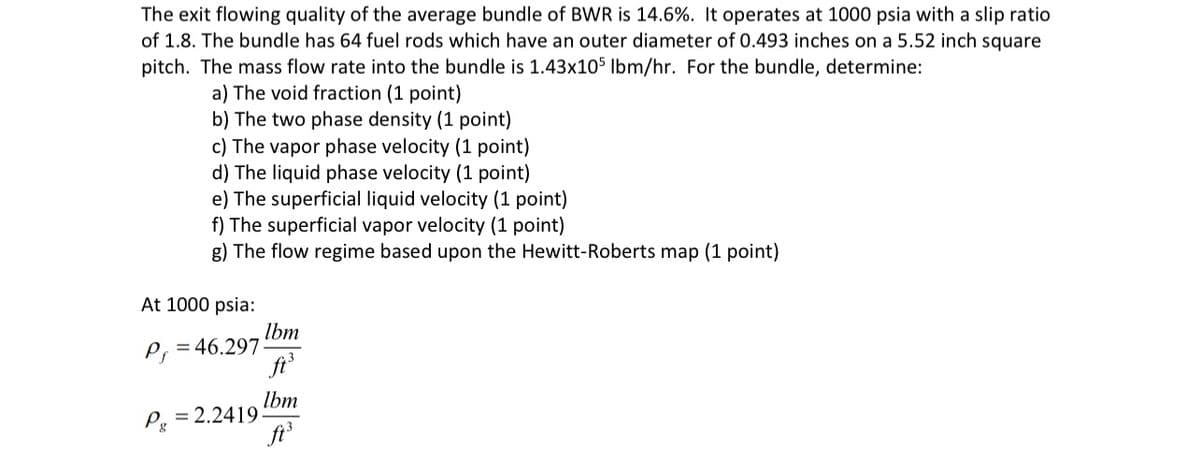The exit flowing quality of the average bundle of BWR is 14.6%. It operates at 1000 psia with a slip ratio of 1.8. The bundle has 64 fuel rods which have an outer diameter of 0.493 inches on a 5.52 inch square pitch. The mass flow rate into the bundle is 1.43x105 lbm/hr. For the bundle, determine: a) The void fraction (1 point) b) The two phase density (1 point) c) The vapor phase velocity (1 point) d) The liquid phase velocity (1 point) e) The superficial liquid velocity (1 point) f) The superficial vapor velocity (1 point) g) The flow regime based upon the Hewitt-Roberts map (1 point) At 1000 psia: P=46.297- Pg = 2.2419 Ibm ft. Ibm ft.
The exit flowing quality of the average bundle of BWR is 14.6%. It operates at 1000 psia with a slip ratio of 1.8. The bundle has 64 fuel rods which have an outer diameter of 0.493 inches on a 5.52 inch square pitch. The mass flow rate into the bundle is 1.43x105 lbm/hr. For the bundle, determine: a) The void fraction (1 point) b) The two phase density (1 point) c) The vapor phase velocity (1 point) d) The liquid phase velocity (1 point) e) The superficial liquid velocity (1 point) f) The superficial vapor velocity (1 point) g) The flow regime based upon the Hewitt-Roberts map (1 point) At 1000 psia: P=46.297- Pg = 2.2419 Ibm ft. Ibm ft.
Introduction to Chemical Engineering Thermodynamics
8th Edition
ISBN:9781259696527
Author:J.M. Smith Termodinamica en ingenieria quimica, Hendrick C Van Ness, Michael Abbott, Mark Swihart
Publisher:J.M. Smith Termodinamica en ingenieria quimica, Hendrick C Van Ness, Michael Abbott, Mark Swihart
Chapter1: Introduction
Section: Chapter Questions
Problem 1.1P
Related questions
Question

Transcribed Image Text:The exit flowing quality of the average bundle of BWR is 14.6%. It operates at 1000 psia with a slip ratio
of 1.8. The bundle has 64 fuel rods which have an outer diameter of 0.493 inches on a 5.52 inch square
pitch. The mass flow rate into the bundle is 1.43x105 lbm/hr. For the bundle, determine:
a) The void fraction (1 point)
b) The two phase density (1 point)
c) The vapor phase velocity (1 point)
d) The liquid phase velocity (1 point)
e) The superficial liquid velocity (1 point)
f) The superficial vapor velocity (1 point)
g) The flow regime based upon the Hewitt-Roberts map (1 point)
At 1000 psia:
P=46.297-
Pg
= 2.2419
Ibm
ft.
Ibm
ft.
Expert Solution
This question has been solved!
Explore an expertly crafted, step-by-step solution for a thorough understanding of key concepts.
This is a popular solution!
Trending now
This is a popular solution!
Step by step
Solved in 2 steps with 2 images

Recommended textbooks for you

Introduction to Chemical Engineering Thermodynami…
Chemical Engineering
ISBN:
9781259696527
Author:
J.M. Smith Termodinamica en ingenieria quimica, Hendrick C Van Ness, Michael Abbott, Mark Swihart
Publisher:
McGraw-Hill Education

Elementary Principles of Chemical Processes, Bind…
Chemical Engineering
ISBN:
9781118431221
Author:
Richard M. Felder, Ronald W. Rousseau, Lisa G. Bullard
Publisher:
WILEY

Elements of Chemical Reaction Engineering (5th Ed…
Chemical Engineering
ISBN:
9780133887518
Author:
H. Scott Fogler
Publisher:
Prentice Hall

Introduction to Chemical Engineering Thermodynami…
Chemical Engineering
ISBN:
9781259696527
Author:
J.M. Smith Termodinamica en ingenieria quimica, Hendrick C Van Ness, Michael Abbott, Mark Swihart
Publisher:
McGraw-Hill Education

Elementary Principles of Chemical Processes, Bind…
Chemical Engineering
ISBN:
9781118431221
Author:
Richard M. Felder, Ronald W. Rousseau, Lisa G. Bullard
Publisher:
WILEY

Elements of Chemical Reaction Engineering (5th Ed…
Chemical Engineering
ISBN:
9780133887518
Author:
H. Scott Fogler
Publisher:
Prentice Hall


Industrial Plastics: Theory and Applications
Chemical Engineering
ISBN:
9781285061238
Author:
Lokensgard, Erik
Publisher:
Delmar Cengage Learning

Unit Operations of Chemical Engineering
Chemical Engineering
ISBN:
9780072848236
Author:
Warren McCabe, Julian C. Smith, Peter Harriott
Publisher:
McGraw-Hill Companies, The